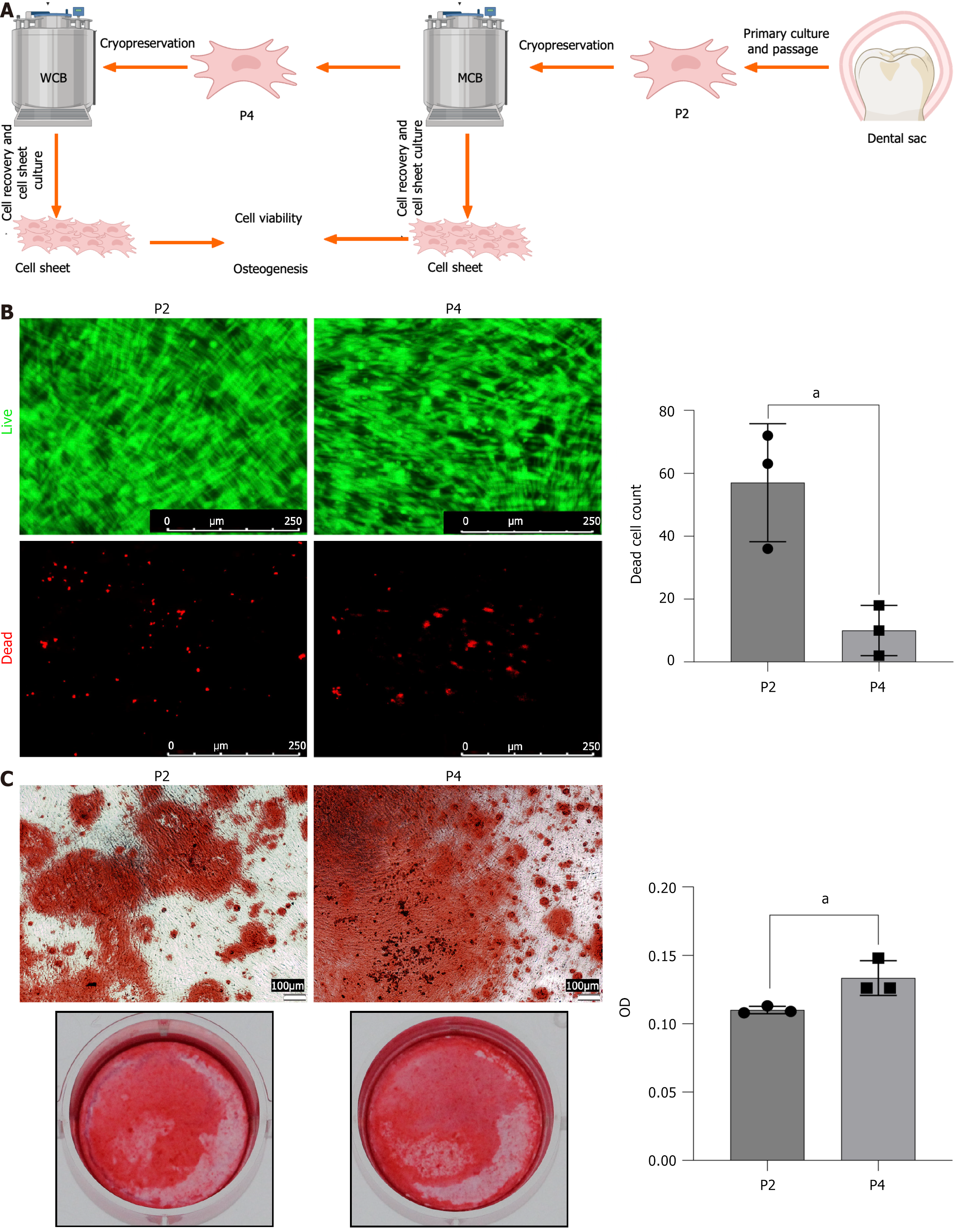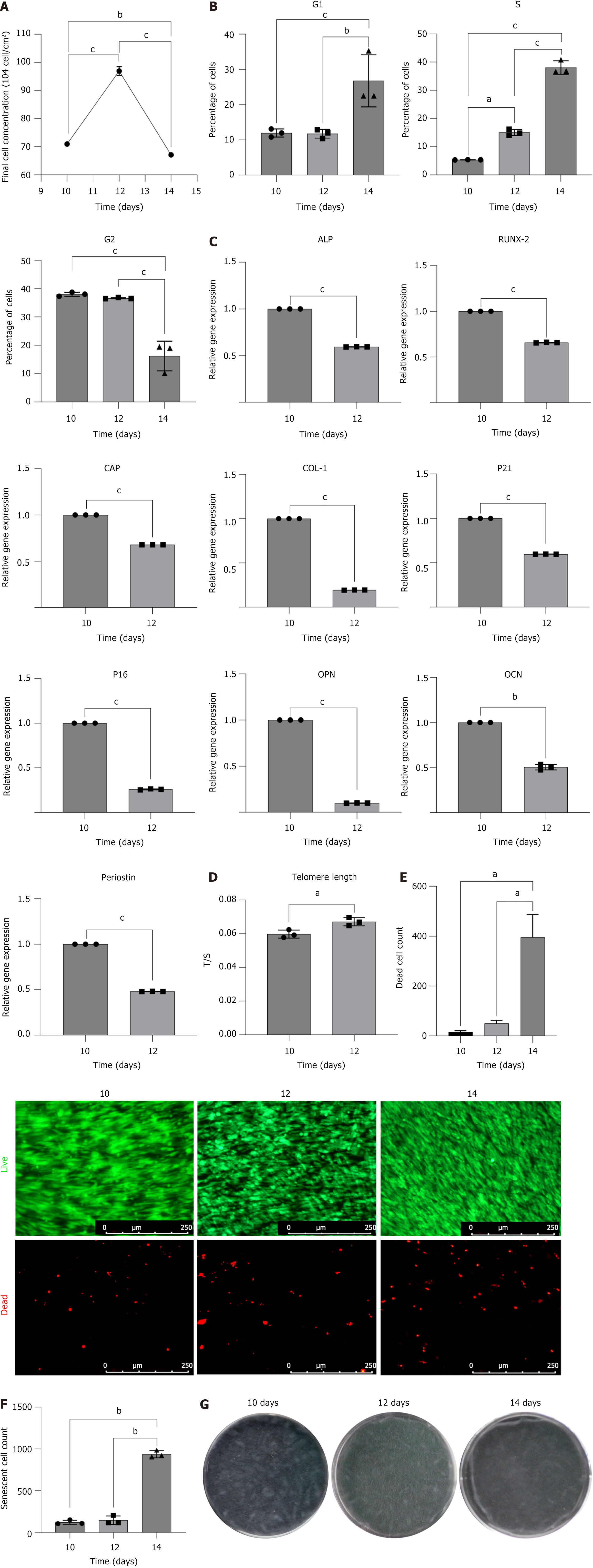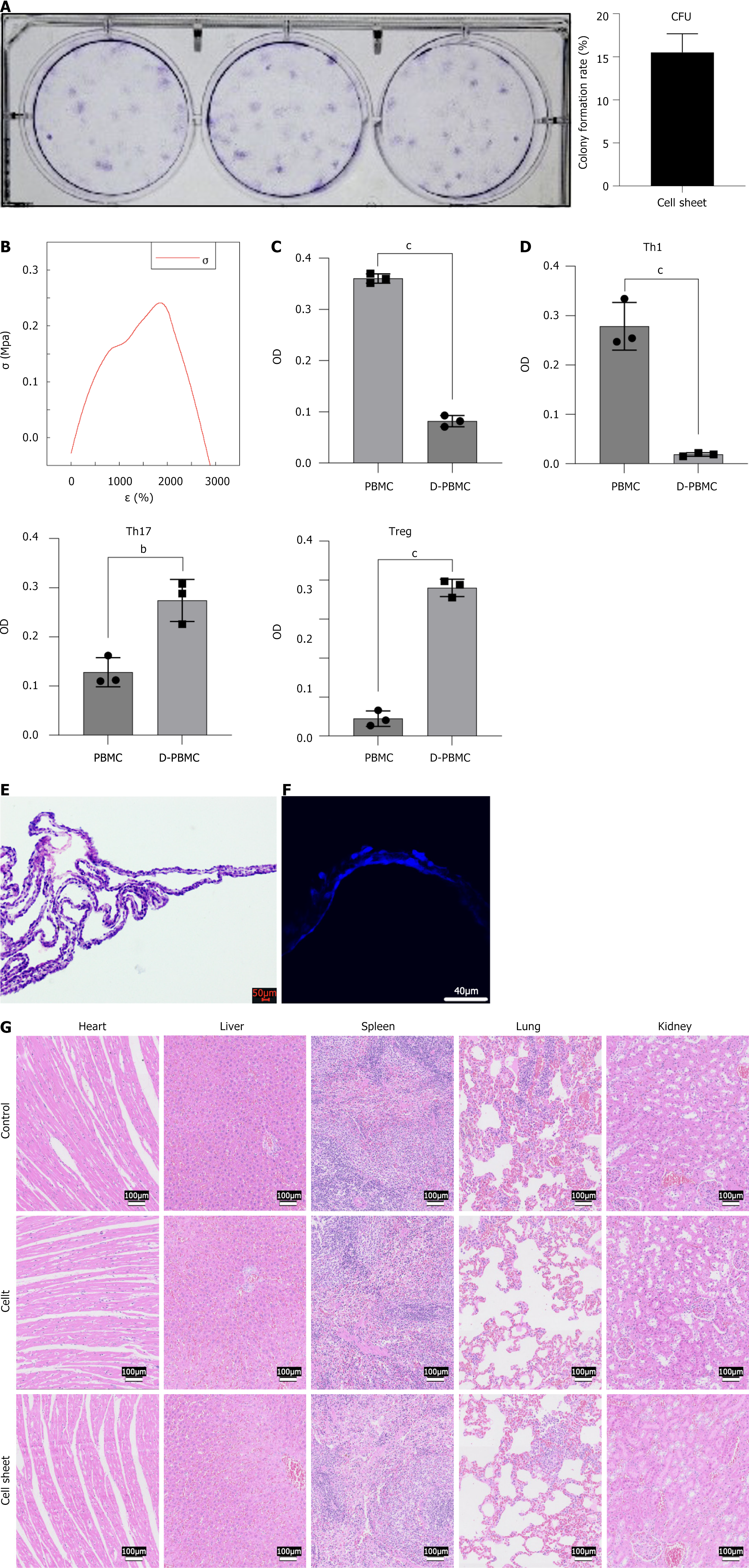Copyright
©The Author(s) 2025.
World J Stem Cells. May 26, 2025; 17(5): 104116
Published online May 26, 2025. doi: 10.4252/wjsc.v17.i5.104116
Published online May 26, 2025. doi: 10.4252/wjsc.v17.i5.104116
Figure 1 The effect of cell generation on the characteristics of dental follicle stem cell sheet.
A: Schematic representation of dental follicle stem cell sheets cultured from cells at different passages. Created with BioRender.com; B: Quantitative analysis of dead cells in sheets cultured from cells at different passages. Scale bar = 250 μm; C: Alizarin red staining of cell sheets cultured at different passages. Scale bar = 100 μm. Data are presented as mean ± SD, n = 3. aP < 0.05.
Figure 2 The effect of time on the characteristics of dental follicle stem cell sheet.
A: Variation in the cell count within the cell sheet over time; B: Flow cytometry analysis of cell cycle phases in cell sheets at various time points; C: Quantitative reverse-transcription polymerase chain reaction analysis of the genes related to osteogenesis, chondrogenesis, odontogenesis, and aging at different time points; D: Quantitative reverse-transcription polymerase chain reaction analysis of telomere length in the cell sheets at different time points; E: Acridine orange/propidium iodide staining of cell sheets at different time points by the quantitative analysis of dead cells. Scale bar = 250 μm; F: Quantitative assessment of β-galactosidase staining in cell sheets at different time points; G: Morphology of the dental follicle stem cell sheets at various time points. Data are presented as mean ± SD, n = 3. aP < 0.05; bP < 0.01; cP < 0.001. ALP: Alkaline phosphatase; RUNX-2: Runt-related transcription factor 2; CAP: Cartilage associated protein; COL-1: Type I collagen; OPN: Osteopontin; OCN: Osteocalcin.
Figure 3 The effect of inoculation cell concentration on the characteristics of cell sheet.
A: Acridine orange/propidium iodide staining and quantitative analysis of dead cells in cell sheets at varying initial cell concentrations. Scale bar = 100 μm; B: Final cell count in cell sheets at various seeding densities; C: Quantitative reverse-transcription polymerase chain reaction analysis of osteogenic, chondrogenic, odontogenic, and senescence-related genes in cell sheets with different seeding densities; D: Quantitative assessment of β-galactosidase staining in cell sheets at varying initial cell concentrations; E: Relative telomere length in cell sheets cultured at various cell concentrations; F: Measurement of hydroxyproline content in cell sheets at different initial cell concentrations; G: Measurement of glycosaminoglycan content in cell sheets at different initial cell concentrations; H: Alizarin red staining of cell sheets cultured at different initial cell densities. Scale bar = 100 μm. Data are presented as mean ± SD, n = 3. aP < 0.05; bP < 0.01; cP < 0.001. ALP: Alkaline phosphatase; RUNX-2: Runt-related transcription factor 2; CAP: Cartilage associated protein; COL-1: Type I collagen; OPN: Osteopontin; OCN: Osteocalcin; β-GAL: β-galactosidase; HYP: Hydroxyproline; sGAG: Sulfated glycosaminoglycan.
Figure 4 The effect of L-ascorbic acid concentration on the characteristics of cell sheet.
A: Acridine orange/propidium iodide staining and quantitative analysis of dead cells in the cell sheets at various L-ascorbic acid concentrations. Scale bar = 250 μm; B: Quantitative reverse-transcription polymerase chain reaction analysis of osteogenic and senescence-related genes in cell sheets cultured with various L-ascorbic acid concentrations; C: Final cell counts in the cell sheets at various L-ascorbic acid concentrations; D: Measurement of hydroxyproline content in the cell sheets at different L-ascorbic acid concentrations; E: Measurement of the sulfated glycosaminoglycan content in cell sheets with varying L-ascorbic acid concentrations. Data are presented as mean ± SD, n = 3. aP < 0.05; bP < 0.01; cP < 0.001. ALP: Alkaline phosphatase; RUNX-2: Runt-related transcription factor 2; CAP: Cartilage associated protein; HYP: Hydroxyproline; sGAG: Sulfated glycosaminoglycan.
Figure 5 Physical and biological characteristics of standardized cultured cell sheet.
A: Macroscopic image of cell colony formation experiment and corresponding quantitative analysis; B: Stress-strain curve of cell sheet under tensile load; C: Lymphocyte proliferation inhibition test results; D: Flow cytometry analysis and quantitative data of the proportion of type 1 T helper, interleukin-17-producing T helper, and regulatory T cells; E: 4’,6-Diamidino-2-phenylindole staining of cell sheet. Scale bar = 40 μm; F: Hematoxylin and eosin staining of cell sheet. Scale bar = 50 μm; G: Hematoxylin and eosin staining of rat heart, liver, spleen, lung, and kidney sections after implantation with cell sheet, cell suspension, and phosphate-buffered saline. Scale bar = 100 μm. Data are presented as mean ± SD, n = 3. aP < 0.05; bP < 0.01; cP < 0.001. CFU: Colony formation unit; Th1: Type 1 T helper; Th17: Interleukin-17-producing T helper; Treg: Regulatory T cell.
Figure 6 Comparison of cell sheet and cell suspension.
A: Alizarin red staining comparison between cell sheets and cell suspensions (n = 3). Scale bar = 100 μm; B: Enzyme linked immunosorbent assay results showing vascular endothelial growth factor and angiopoietin-1 concentrations secreted by cell sheets and cell suspensions (n = 3); C: Micro-computed tomography images of the defect area at four weeks, with the defect region outlined by a red dotted line (2 mm × 1 mm) (n = 6); D: Quantitative analysis of the defect area at four weeks (n = 6) including trabecular separation, bone volume/tissue volume ratio, trabecular thickness, and trabecular number values; E: Hematoxylin and eosin, tartrate-resistant acid phosphatase, and Masson staining for periodontal regeneration. Collagen fibers are stained blue in Masson’s stain. The orange arrow indicates tartrate-resistant acid phosphatase-stained osteoclasts, while the black dashed line marks the boundary of newly formed alveolar bone. Scale bar = 50 μm (Ab: Alveolar bone; c: Cementum; p: Periodontal membrane). Data are presented as mean ± SD, aP < 0.05; bP < 0.01; cP < 0.001. VEGF: Vascular endothelial growth factor; ANG-1: Angiopoietin-1; BV: Bone volume; TV: Tissue volume.
- Citation: Yu JL, Yang C, Liu L, Lin A, Guo SJ, Tian WD. Optimal good manufacturing practice-compliant production of dental follicle stem cell sheet and its application in Sprague-Dawley rat periodontitis. World J Stem Cells 2025; 17(5): 104116
- URL: https://www.wjgnet.com/1948-0210/full/v17/i5/104116.htm
- DOI: https://dx.doi.org/10.4252/wjsc.v17.i5.104116














